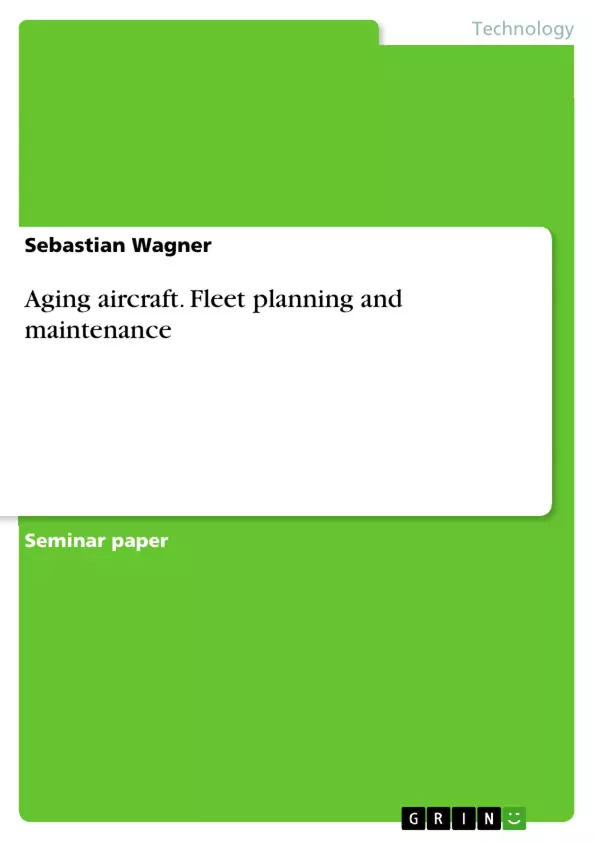Indeed, the majority of airlines are faced with the challenge of aging fleets and when it might be optimal to replace older aircraft. Well, any discussion of the wisdom of retaining capital equipment is usually based on economic arguments. In a competitive environment, airlines are continuously obliged to improve their business and equipment to stay profitable.
The prediction of future maintenance costs of the own fleet is an integral element of prospective budgeting projections; on the other hand they serve as a vital part within aircraft replacement calculations. For example if the costs of maintaining the existing equipment on a timely basis exceeds the capital, interest, and amortization charges on replacement equipment, the decision to buy a sort of replacement is straightforward. In most cases the substitute
equipment even offers an improved productivity as well (Dixon 2006, p. 1).
Beside any debate concerning costs and efficiency, flight safety considerations also enter into the discussion especially in the field of aviation. The question to repair or replace is an ongoing decision making process for the maintenance department of every airline operator.
Now the key questions to be answered in this context are: Is it possible to describe a standard airplane service life and how does the fleet age of world’s leading airlines look like? How does the process of maintenance develop over an aircraft’s whole life cycle and can necessary costs be estimated? What can be done technically to keep aging effects of aircraft under control and when might be the right time to withdraw an aircraft from service?
In order to answer the abundance of questions my term paper is divided into an economic based part including compiled data and statistics and a more technical part. In the beginning, this paper investigates the ordinary economic life of commercial airplanes. Additionally I’m going to inspect exemplary the average fleet age of world’s leading airlines. In the second stage I am going to describe how to estimate maintenance costs of aircraft that grow older.
Further I wanted to clarify technical aspects and problems that might occur more frequently with the rising age of an aircraft.
Table of Contents
- 1 Introduction
- 2 Fleet Planning & Development
- 2.1 The Economic Life of an Aircraft
- 2.2 Airline Fleets - A Market Overview
- 3 Maintenance of Aging Aircraft
- 3.1 The Effect of Age on Total Maintenance Costs
- 3.2 Aging Affect on Aircraft Structures
- 4 Conclusion
Objectives and Key Themes
This paper aims to investigate the economic life and maintenance considerations of aging aircraft. It explores the factors influencing aircraft retirement decisions, the impact of age on maintenance costs, and technical challenges associated with maintaining older aircraft.
- Economic Life of Aircraft
- Maintenance Cost Estimation
- Technical Challenges of Aging Aircraft
- Fleet Planning Strategies
- Aircraft Retirement Decisions
Chapter Summaries
- Chapter 1: Introduction This chapter introduces the topic of aging aircraft and the challenges faced by airlines in maintaining their fleets. It discusses the importance of balancing economic considerations, flight safety, and technical aspects in decision-making regarding aircraft retirement.
- Chapter 2: Fleet Planning & Development This chapter delves into the concept of "airplane economic life" and explores various factors affecting fleet planning decisions. It examines the average fleet age of leading airlines and analyzes the trends in aircraft retirement rates.
- Chapter 3: Maintenance of Aging Aircraft This chapter focuses on the impact of age on aircraft maintenance costs and technical challenges. It investigates the increasing maintenance requirements and potential structural issues that arise with older aircraft.
Keywords
The primary keywords and focus topics of this paper include aircraft retirement, fleet planning, maintenance costs, aging aircraft, economic life, aircraft structures, airworthiness, and safety.
- Quote paper
- Diplom-Kaufmann Sebastian Wagner (Author), 2014, Aging aircraft. Fleet planning and maintenance, Munich, GRIN Verlag, https://www.grin.com/document/272855



